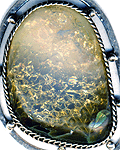BAD

 Characteristics of the mineral.
Characteristics of the mineral.
In the process of evolution and aging, opal loses some of the water contained in it. The transitional mineral, in which part of it has passed into chalcedony, but the bound water zones in the internal structure are preserved, is called the half-ople. This is not a scientific name, as gemologists do not separate it from opal. To meet half-birds suitable for jewelry needs is a rarity. The half-dip is not afraid of moisture, temperature and does not burn out. On the properties it resembles chalcedony, but it has some differences in the internal structure (color lenses, scattic cracks and transitions).
Qualitative half-wool is rare, rather resistant and is valued above ornamental opals, being an original semi-precious or precious stone. All the charm of semi-ovals is in the features of their internal structure and unique structure. Sometimes semi-croups are referred to as cacholongs, because they are also an intermediate stage in the evolution between opal and chalcedony.


Transformations of opals in the course of evolution
From opal to half-dust and cacholong and further to chalcedony and agate.
In the process of evolution, completely lost their water, opals and semi-ovals pass into agate and chalcedony, which are the final stage of the evolution of all opals. The history of noble opals began millions of years ago, when part of the land was covered by the sea, on the lagoons of which sedimentary rocks were deposited. In the cracks and voids of these rocky sedimentary rocks accumulated rich in silicon water, the remains of plants and animals. Silicon slowly turned into opal, because opal is silicic acid and water. In the process of aging over millions of years, opal has lost all water, but can continue to be as layered chalcedony and agate lenses coated with a brush of crystallized quartz, in other rocks in which silicic acid was previously accumulated and noble opals formed (the photo below shows the final The aging stage of opal: thin-layer agate, formed from opal).

Very characteristic Ukrainian Transcarpathian chloropals take excellent mirror polish. The stone is beautiful in color; Dense and translucent differences with success can be used in stone cutting and jewelry works. The peculiarity of this borderline form of opal and chalcedony (which can therefore be called a half-octopus) is that this opal does not crumble into fine dust when dried, but can crack into smaller and smaller fragments. Therefore, it is desirable to use an additional protective coating at the finishing stage of processing such opals. These opals are characteristic stones of Ukraine.
On the north-western outskirts of Uzhhorod there is an old abandoned quarry, where in 1839 E. Glocker found a stone described by him under the name Ungovarit. Later it turned out that this is not a new mineral with a special composition and structure, but a well-known opal with an admixture of the clay mineral of nontronite and iron hydroxides. Because of the green color, this stone is often referred to in the literature as chloropal. However, it can be colored differently, but most often there are green tones. The color of the ungovarite is determined by the color of the nontronite and can be greenish-yellow, pistachio-green, brown, amber-yellow, red-brown, grayish-blue and black. The stone is very beautiful and slightly translucent in chips and polishes, like jade or amber.
Ungovarit is most often found among the andesite rocks of the northwestern part of the Vigolat-Gutinsky volcanic ridge. Its formation is associated with the activity of hot gases and solutions circulating in a massif of solidified lava. The gem is found in the form of nodules and nests in andesites and sporadically scattered in the most diverse parts of the lava flows. Its secretions are spherical, ellipsoidal or completely irregular in shape. In the walls of quarries it was possible to find ungovaritic fillings with a diameter of more than 2 m. In the nuclei of its largest globular discharge there is a pure translucent opal of white color with characteristic annular cracks and voids resulting from dehydration and aging of the stone. When a hammer blows, the monolithic pieces are easily broken into sharp-edged fragments. The jaws of the ungovariate from the outside usually have a green color, which is replaced by light brown and yellow towards the center. The photo shows Ukrainian opals.




Poisonous and radioactive dangerous stones and minerals
** - poisonous stones and minerals (mandatory check in the chemical laboratory + explicit indication of toxicity).
** - radioactive stones and minerals (mandatory check on the standard dosimeter + ban on open sales in the case of radioactivity over 24 milli / g / h + additional measures of population protection).
All rare stones are subject to mandatory inspection at the standard dosimeter for the permissible level of radiation and in the chemical laboratory for the absence of poisonous and evaporating components that are dangerous to humans and the environment.


Comments
Commenting on, remember that the content and tone of your message can hurt the feelings of real people, show respect and tolerance to your interlocutors even if you do not share their opinion, your behavior in the conditions of freedom of expression and anonymity provided by the Internet, changes Not only virtual, but also the real world. All comments are hidden from the index, spam is controlled.